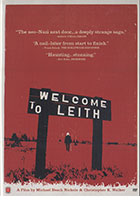
Welcome to Leith 2015
Distributed by First Run Features, 630 Ninth Avenue, Suite 1213, New York, NY 10036; 212-243-0600
Produced by Jenner Furst
Directed by Michael Beach Nichols and Christopher K. Walker
DVD , color, 86 min.
High School - General Adult
Sociology, Social Sciences, Politics, History, Democracy, Activism, Aggression, Diversity, Political Rights, Government, Discrimination, Civil Rights, Culture, Documentaries
Date Entered: 03/30/2016
Reviewed by Joseph Baumstarck, Jr., University of Louisville, Southern Baptist Theological Seminary, Ivy Tech Community CollegeA well done documentary with the drama of a movie Welcome to Leith leaves the thinking viewer with a very unsettled feeling and more questions than answers. In a mostly objective storyline the trials of a small North Dakota town confronted with forces far beyond its ability to control, contain, or assimilate are documented through a long-term struggle. The basic outcome is what one would expect, but the questions raised along the way are what gives this documentary its academic appeal.
This is a multi-layered story which begs answers to some of democracies most basic questions. Although it documents the following struggles well the film makes no pretense at presenting a final answer to these questions. How is a community to deal with viewpoints that are uncomfortable and outside the range of those they have grown up to expect? Do outsiders have a role in a remote North Dakota town’s internal politics and lifestyle? If so how is this role engaged in by political activists who do not live there or individuals holding minority opinions who wish to move there and take over the local political machinery? How does a legally enforced version of community and correct behavior interact with a local belief system that is rapidly driven askew by outside forces? How do freedom of speech and thought function in a supposedly democratic process when the legal system is used to suppress unpopular or minority viewpoints?
This highly recommended film has clear application in high school and college level social science, political science, and history courses. It would also work well for adult discussion groups outside the academic setting or for seminar programs.
Several weaknesses exist in the documentary, but are more than offset by the overall quality of the work. These include some limited segments of garbled voice quality without sub-texting, some brief video segments that were unclear or showed less than optimal fields of view which were not adequately edited, and a few segments where the audio clip did not enhance the video images shown. These problems are explainable given the nature of the film, but better editing could have fixed some of these issues while retaining the character of the film. The producers seem to be clearly on the side of the majority yet attempt to portray the opposite position as well, though some of the balancing viewpoint is positioned in the extra material included on the DVD. The extra material is a useful feature of this production and its viewing should be encouraged. Some segments of course language, although not simply gratuitous but an integral part of the documentary, make this video less applicable to younger age groups and inappropriate in some settings.